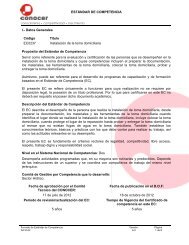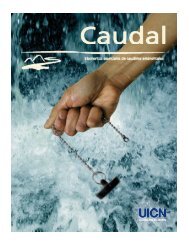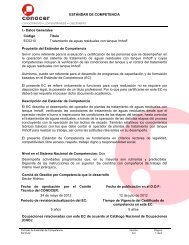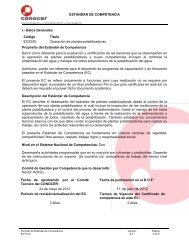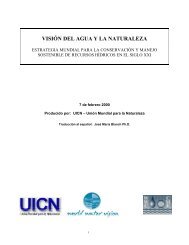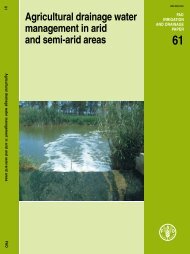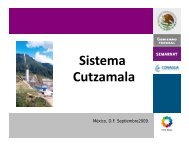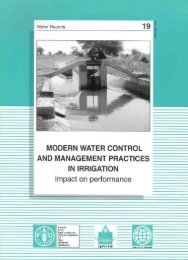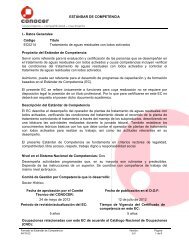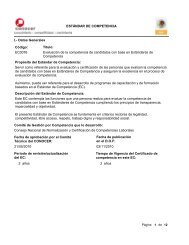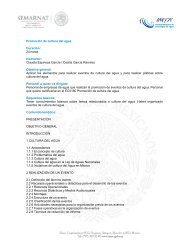The Conservation and Sustainable Use of Freshwater ... - IUCN
The Conservation and Sustainable Use of Freshwater ... - IUCN
The Conservation and Sustainable Use of Freshwater ... - IUCN
You also want an ePaper? Increase the reach of your titles
YUMPU automatically turns print PDFs into web optimized ePapers that Google loves.
lower reaches <strong>of</strong> the Syrdarya river <strong>and</strong> in the northern part<br />
<strong>of</strong> the Aral Sea, so that measures to sustain <strong>and</strong> regulate<br />
the water/ecological situation in the region could be implemented<br />
based on scientific <strong>and</strong> engineering justification.<br />
Since the issue <strong>of</strong> creating controlled wetl<strong>and</strong> complexes<br />
at the lower reaches <strong>of</strong> the Syrdarya river has not been<br />
studied sufficiently, it is necessary to thoroughly clarify<br />
contents, scope, <strong>and</strong> regime <strong>of</strong> operating water bodies <strong>and</strong><br />
connecting canals with the application <strong>of</strong> modeling <strong>and</strong><br />
simulation tools. Clear justification is needed as to what<br />
lakes should be preserved - what parameters (area <strong>of</strong> water<br />
surface, depth) <strong>and</strong> what regimes <strong>of</strong> water inflow should<br />
be taken into consideration, <strong>and</strong> which lakes are to be excluded<br />
from water management system as inexpedient.<br />
Apart from the above-mentioned additional measures,<br />
there is a necessity to establish a consortium (or some<br />
other water association) for delta management, which<br />
could perform its functions with the participation <strong>of</strong> all<br />
water users <strong>and</strong> other stakeholders, including governmental<br />
agencies <strong>and</strong> provincial authorities. This organization<br />
should arrange its interrelations with BWO “Syrdarya” on<br />
a contractual basis, collecting charges for mutual services<br />
<strong>and</strong> clear definition <strong>of</strong> reciprocal obligations.<br />
Suggested measures imply the stabilization <strong>of</strong> the situation<br />
in the Priaralye delta zone <strong>and</strong> the provision <strong>of</strong> guaranteed<br />
water levels in lakes, <strong>and</strong> will facilitate restoration,<br />
protection, <strong>and</strong> well-balanced use <strong>of</strong> water resources. <strong>The</strong>y<br />
could become a key factor, which allows rapid retrieving<br />
<strong>of</strong> a normal state for currently distorted ecosystems <strong>and</strong><br />
retains the NAS in the capacity <strong>of</strong> a natural object.<br />
Major consequences <strong>of</strong> the Aral Sea desiccation, alongside<br />
the reduction <strong>of</strong> its volume, water surface area <strong>and</strong><br />
aggravation <strong>of</strong> mineralization processes, are reflected in<br />
the formation <strong>of</strong> a vast salt desert on the dried-up former<br />
sea bottom, the area <strong>of</strong> which has reached almost 3.6 million<br />
ha. As a result, the unique fresh water reservoir has<br />
been replaced by a vast bitter saline lake combined with<br />
an enormous salt-<strong>and</strong>-s<strong>and</strong> desert located at the junction<br />
<strong>of</strong> three s<strong>and</strong> deserts. In 1985 – 1986 when the sea level<br />
reached 41 abs m, the full partition <strong>of</strong> the Small Sea from<br />
the Large Sea took place. This led to the formation <strong>of</strong> a<br />
new desert territory covering an area <strong>of</strong> 6,000 km2 with<br />
salt storages in the topsoil layer reaching up to 1 billion<br />
ton. Thus, the Aral Sea, a single inl<strong>and</strong> lake in the past,<br />
will become in the nearest future a set <strong>of</strong> separate water<br />
bodies, each with its own water-salt balance. <strong>The</strong> fate <strong>of</strong><br />
the future depends on what policies the five Central Asian<br />
countries will choose to pursue with regard to the Aral Sea.<br />
(Dukhovny et al, 2004b)<br />
Reduction <strong>of</strong> the river run<strong>of</strong>f to the delta has caused a<br />
decrease in inflow to all delta lakes <strong>and</strong> flood plains <strong>of</strong> the<br />
Syrdarya river, bringing ecosystems to the brink <strong>of</strong> collapse<br />
<strong>and</strong> exceeding the bounds <strong>of</strong> socio-economic <strong>and</strong><br />
ecological problems <strong>of</strong> the region.<br />
If the current situation in the Syrdarya river delta <strong>and</strong> in<br />
Priaralye in general is not changed, then the critical ecological<br />
situation here will be retained.<br />
References<br />
Dukhovny, V. A. Avakyan, I. S. Rubin, M. G. Van Dike, A. Malygin,<br />
S. A. & Prikhodko, V. G. (2001) Assessment <strong>of</strong> the Social-Economic<br />
Damage Under the Influence <strong>of</strong> the Aral Sea Level Lowering (Uzbek<br />
Part <strong>of</strong> the Aral Sea Coastal Zone). INTAS-RFBR 1733 [final report].<br />
Dukhovny, V. A. Kipshakbaev, N. K. Prikhodko, V. G. Ruziev, I. B.<br />
& Budnikova, T. I. Influence <strong>of</strong> the Aral Sea Shrinkage on Socio-Economic<br />
<strong>and</strong> Environmental Changes in Northern Priaralye [final report].<br />
Dukhovny, V. A. Kipshakbaev, N. K. Prikhodko, V. G. Ruziev, I. B. &<br />
Budnikova, T. I. (2004a) Water-Ecological Problems <strong>of</strong> the Syrdarya<br />
River Delta <strong>and</strong> Measures to Solve <strong>The</strong>m. IN: ECWATECH, 1 – 4<br />
June, Moscow.<br />
Dukhovny, V. A. Prihodko, V. G. & Ruziev, I. B. (2004b) North Aral<br />
Sea, the Syrdarya Delta <strong>and</strong> Priaralye. IN: ECWATECH, 1 – 4 June,<br />
Moscow.<br />
Ruziev, I. B. & Prikhodko, V. G. (2003) Influence <strong>of</strong> the Aral Sea<br />
Shrinkage on Socio-Economic <strong>and</strong> Environmental Changes in Northern<br />
Priaralye. IN: International Regional Conference for Central Asia<br />
- Environmental Sustainability <strong>and</strong> Advanced Approaches to Water<br />
Resources Management in the Aral Sea Basin, 5 – 7 May, Almaty.<br />
31



